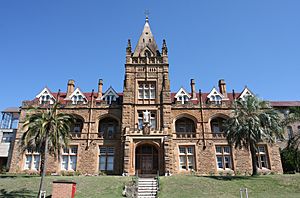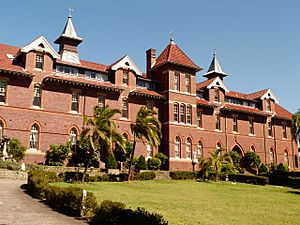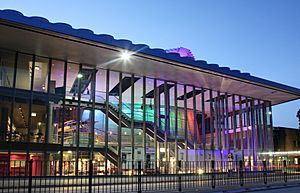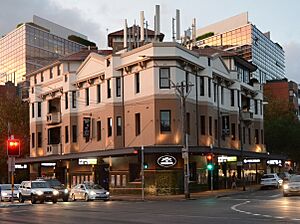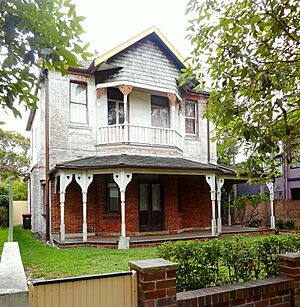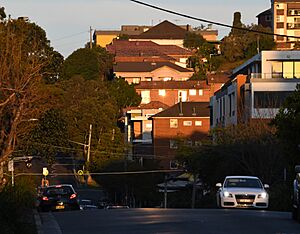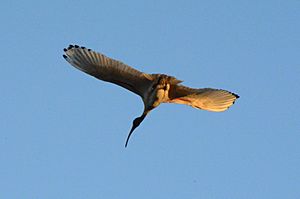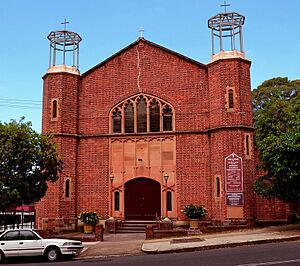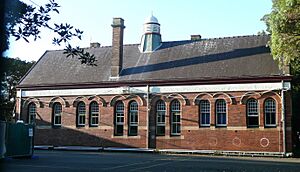Kensington, New South Wales facts for kids
Quick facts for kids KensingtonSydney, New South Wales |
|||||||||||||||
|---|---|---|---|---|---|---|---|---|---|---|---|---|---|---|---|
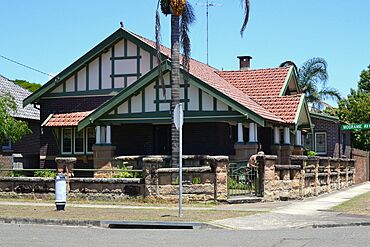
A California bungalow in Kensington
|
|||||||||||||||
| Postcode(s) | 2033 | ||||||||||||||
| Elevation | 30 m (98 ft) | ||||||||||||||
| Location | 4 km (2 mi) south-east of Sydney CBD | ||||||||||||||
| LGA(s) | City of Randwick | ||||||||||||||
| State electorate(s) | Heffron | ||||||||||||||
| Federal Division(s) | Kingsford Smith | ||||||||||||||
|
|||||||||||||||
Kensington is a lively suburb in the eastern part of Sydney, New South Wales, Australia. It is located just four kilometres south-east of the Sydney city centre. Kensington is part of the City of Randwick, which is a local government area.
This suburb is found just south of Moore Park and west of Randwick Racecourse. Some of the main places you'll find here include the University of New South Wales, the National Institute of Dramatic Art, and the Australian Golf Club. Kensington is also a popular place for people to live because it's so close to the city.
Contents
History of Kensington
First Inhabitants
Long before Europeans arrived, the Cadigal people lived in this area. They were one of the "salt-water clans" of the Darug language group. The Cadigal people were skilled at fishing and often used canoes. In 1828, about 50 to 60 Cadigal groups lived near the Lachlan swamps in Kensington. These swamps provided them with fruits, roots, and other foods. Today, very few Aboriginal people live in Kensington.
European Settlement and Growth
The area we now call Kensington had a few different names in the past. It was known as "Lachlan Mills Estate," "Stannumville," and "Epsom." It officially became Kensington in the late 1880s. It started as a place with many factories and businesses.
An early settler named Samuel Terry received land here in 1819. Later, Daniel Cooper bought land in 1825. His nephew, also named Daniel, planned to divide the land for homes. However, in 1865, new buildings were not allowed. Residential land became available in the late 1880s. The idea was for Kensington to be as fancy as the famous Kensington suburb in London.
Kensington Racecourse
The Kensington Racecourse opened in 1893. It was located where the University of New South Wales stands today. This racecourse held horse races during the week and pony races. It also hosted sports like polo.
The racecourse was used for important events during wartime. Troops and horses stayed there during the Second Boer War, World War I, and World War II. Many of the first Anzacs trained at Kensington Racecourse in 1914. They trained there before going to Egypt and Gallipoli. After World War II, in the late 1940s, it became a hostel for new migrants. In 1950, the land was taken over to build Sydney's second university.
Old Factory and New Homes
The WD & HO Wills factory opened on Todman Avenue in 1902. This factory site also had the Raleigh Park Social Club. It was a large sports complex named after Sir Walter Raleigh. The factory closed in 1989. Over time, it was turned into a residential area called Raleigh Park. The original factory building is a two-storey brick building. It was designed around 1930 and is now a heritage-listed site.
Street Names of Kensington
Many streets in Kensington are named after local people, places in London, or local plants. Here are some examples:
- Balfour Lane – named after Arthur James Balfour, a British Prime Minister.
- Doncaster Avenue – named after Doncaster Racecourse in England.
- Boronia Street – Boronia is a type of flowering shrub that grows in the area.
Sacred Heart Monastery
The Sacred Heart Monastery sits on a hill in West Kensington. It is the main office in Australia for the Missionaries of the Sacred Heart, a Catholic group. The monastery was built in 1895. It is a large stone building with a Gothic style. It has a tall central tower. There is also a brick chapel built in 1939. This monastery is a well-known landmark in Kensington.
Next to the monastery is the Our Lady of the Sacred Heart Convent. This brick building was built in 1897. It was originally a school. Now, it is home to the OLSH Provincial House and St Joseph's Aged Care Facility. Our Lady of the Sacred Heart College (a high school) is right next door. Across the road, you'll find Our Lady of the Rosary Church (built 1906), Jubilee Hall, and Our Lady of the Rosary Primary School. Together, these buildings form a large religious complex. The convent and church are also heritage-listed.
Tram History
Kensington used to have a tram system. The line from Surry Hills to West Kensington started in 1881. It was first powered by steam. Over the years, the line was extended. The tram line down Crown Street closed in 1957. The rest of the line stayed open until 1961.
Trams also ran along Anzac Parade. These trams went to places like Maroubra and La Perouse.
Tay Park is a special spot. It was once a Toll Bar from 1854 to 1894. People had to pay a fee there to help pay for road maintenance. For example, a four-wheeled wagon pulled by two horses cost 1 shilling.
Shopping and Businesses
Kensington's businesses are greatly influenced by the University of New South Wales and the horse racing industry. You can find many cafes, restaurants, and shops here. There is a long shopping street along Anzac Parade. It continues south into Kingsford. Peters of Kensington is a famous retail store on Anzac Parade. Kensington is also very close to Randwick Racecourse and Centennial Park.
Getting Around Kensington
Anzac Parade is the main road that runs through Kensington. Many buses travel through Kensington. They connect the suburb to the city centre and other nearby areas.
In April 2020, the CBD and South East Light Rail opened. This light rail system connects Kensington to Circular Quay and other parts of Sydney.
Geography of Kensington
Land and Landscape
Kensington is part of an area called the Botany Lowlands. The sand under Kensington holds a lot of water, like a big underground lake. Originally, Kensington was very rugged. It had hills, deep valleys, and large swamps. The Lachlan Stream flowed through these swamps. You can still see signs of the old swamps in the south-west corner of Royal Randwick Racecourse and in the ponds of Centennial Park. After heavy rain, some parts of Kensington can still flood. Over time, Kensington has been levelled. Hills were cut down, and the extra soil was used to fill in low areas.
Parks, Plants, and Animals
Kensington has six parks within its three square kilometres. You can find about four hundred native plants here. These include Banksia, Bottlebrush, Waratah, Wattles, and Eucalypt trees. The Randwick City Council has recorded about two hundred and fifty types of native animals with backbones. Over two hundred species of native birds have been seen since 1788.
Kensington Park is the largest park, covering about 2.8 hectares. It attracts many different birds, such as galahs, crows, ibises, and magpies.
Here are the parks in Kensington:
- Fitzpatrick Park, Day Avenue
- Ingram Street Reserve, Ingram Street
- Kokoda Park, Goodwood Street
- Raleigh Park, Brompton Road
- Wills Reserve, Duke Street
- Kensington Park, Edward Avenue
Water Supply
Kensington has two natural water sources: the Lachlan Stream and an underground water supply. To save water, more homes are now using bore water for their gardens. Others are installing tanks and using 'grey water' (water from sinks and showers) for outdoor use.
People of Kensington
In 2021, there were about 11,927 people living in Kensington. Almost half of the people (49.4%) were born in Australia. Other common birthplaces included China (6.1%), India (2.9%), Indonesia (2.9%), and England (2.8%).
Most people (55.4%) spoke English at home. Other languages spoken included Mandarin (7.9%), Greek (3.8%), and Cantonese (3.4%). When it came to religion, 38.0% of people said they had no religion. The next most common religions were Catholic (20.9%), Eastern Orthodox (6.7%), and Anglican (6.3%).
Most homes in Kensington (71.4%) are flats or apartments. About 21.0% are separate houses, and 7.0% are semi-detached or terrace houses.
Schools and Churches
Kensington has several schools and places of worship:
- Kensington Public School
- Our Lady of the Rosary Primary School
- Our Lady of the Sacred Heart College (a high school)
- University of New South Wales
- The National Institute of Dramatic Art (NIDA), located across from the University of New South Wales on Anzac Parade.
- St Martin's Anglican Church
- Our Lady of the Rosary Catholic Church
- St George Coptic Orthodox Church
- FOCUS Indonesia Church (Gereja Focus Indonesia), at UNSW Kensington Campus
Important Buildings and Sites
Kensington has several places that are listed for their historical importance:
- 85 Todman Avenue: Carthona, Kensington
- Sacred Heart Monastery, Roma Avenue
- Our Lady of the Sacred Heart Convent, Kensington Road
- Our Lady of the Rosary Catholic Church, Kensington Road
- Former WD & HO Wills Building, Todman Avenue
- Kensington Public School, Doncaster Avenue
Famous People from Kensington
Many notable people have lived in Kensington, including:
- Monique Adamczak, a tennis player
- Lionel Bowen, a politician
- William McMahon, who became the 20th Prime Minister of Australia
- Roy Rene, a famous comedian
- Mervyn Wood, a rower and police officer


